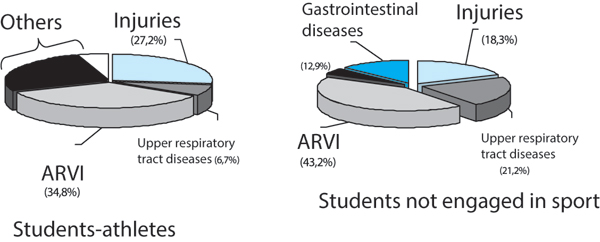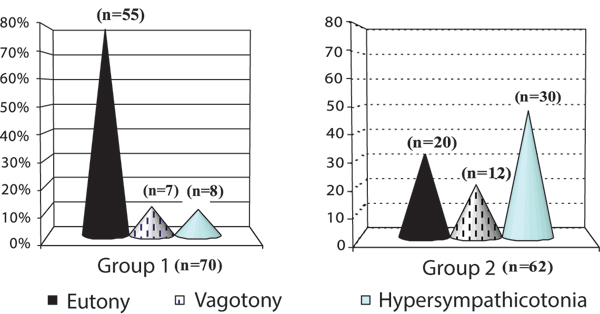Adaptive Changes in Fitness Shape of University Students at Sports Classes
Фотографии:
ˑ:
L.V. Sharova, professor, Dr.Biol.
T.V. Abyzova, associate professor, Ph.D.
N.M. Belokrylov
Perm state humanitarian-pedagogical university, Perm
Key words: body adaptabilities, students, motor activity level, bioinformation technologies.
Relevance. Body adaptabilities (BA) represent one of the fundamental body’s properties and are defined by the level of body's adaptation to the environment. Body state (its health or disease) is a result of the relationship with the environment, i.e. the result of adaptation or deadaptation to environmental conditions [4, 6].
Changing from a healthy state to a disease is usually taken as a process of gradual decline of the person's ability to adapt to changes in the social and processing environments, to the life conditions around him. These very states are studied by rehabilitation medicine and should be subject to control and self-control of health level [10].
University education is a complex and long-term process, making high demands to health. Students’ motor activity is defined by the educational process and consists in mastering the increasing volume of courseware related to knowledge accumulation and development of the intellectual-emotional sphere [2]. University students are subject to substantial psychoemotional and statophysical loadings [7, 8].
Nowadays the problem of students’ adaptation to higher school educational environment is one of essential academic and practical issues being studied [2, 9]. The all-round studies of adaptation to academic load, including sociopsychological and sociophysiological components, is a relevant direction of researches [1, 2, 4, 5, 7, 8, 9].
The purpose of the study was to examine and estimate body adaptabilities of 1-2-year students with different levels of motor activity.
Materials and methods. The purpose was achieved using the following methods: analysis of the methodological literature; questionnaire, analysis of incidence rate according to the data of doctor’s appointments in clinics – the form 039/U-02, № 12, № 57; anamneses vitae, morbi; health assessment using the integrative numerical rating scale of health level by G.L. Apanasenko, estimation of the functional state of the pectoral girdle; vegetative nervous system using: Kerdo index and vegetative reactivity using the orthoclinostatic test; evaluation of mental state: by the blank technology "Wellbeing- Activity - Mood" (WAM) by V.A. Doskin, the Self-esteem scale by Ch.D. Spielberger, Yu.L. Khanin; bioinformation methods of evaluation of mental load with the use of the vegetative resonance test "Imedis-test".
The studies were carried out using the hardware and software complex Imedis-Foll (reg. № 95/311–120), authorized for medical use by MH and the medical industry of the Russian Federation dated September, 15 1995, decree N 311, for the instant diagnosis of body’s functional state by physiological indices of reflectory zones and biologically active points.
132 1-2-year students of the physical culture department of PSHPU and the physical culture department of Perm national research polytechnic university were the subjects of our studies. The students were distributed into groups according to their educational and sports occupations.
Students volunteers were divided into 2 representative groups to estimate the level of their body adaptabilities.
The group 1 was made of students engaged in sport (n=70): The qualification level of the athletes: masters of sport of the RF (n=15), candidates for masters of sport (n=16), Ist senior grade (n=39). The mean age - 20,04±0,33. Boys - 45, girls - 25. The training sessions were held 3-5 times a week.
The group 2 were students not engaged in sport (n=62). Mean age - 19,28 ± 0,33. 38 boys and 24 girls.
Results and discussion. Our analysis of students’ health level at the initial phase of the studies according to the data on doctor’s appointments in medical and preventive treatment facilities in 2007-2012 revealed the dominance of flu and acute respiratory viral infection (ARVI), which amounts to approximately 34,8% cases and 19,4% of days of temporary disability, followed by injuries - 27,2% and 27,8%; upper respiratory tract diseases – 6,7% and 6,4%, gynecopathies - 5,7% and 4,5% in the incidence structure of the students engaged in sport respectively, Fig.1. The share of doctor’s appointments among girls was 9,9% of the total of appointments with prevailing gynecopathies, while boys mostly made appointments regarding ARVI and injuries, where limb injuries are leading, which corresponds to 30% and 25% of the total respectively.

Fig. 1. The comparative analysis of the incidence structure among students with different motor activity levels (%)
Flu and acute respiratory viral infection prevail in the incidence structure of the students not engaged in sport and amount to approximately 43,2% cases and 27,7% of days of temporary disability, upper respiratory tract diseases are on the second place - 21,2% and 33,4%; injuries - 3rd place - 18,3% and 24,4%; and gastrointestinal diseases - 12,9% and 8,8%; gynecopathies - 4,5% and 15,1% respectively, Fig. 1. Concerning girls, the share of doctor’s appointments was 30% of the total with prevailing gynecopathies and ARVI in the structure. As for boys, the temporary disability was mostly related to ARVI and upper respiratory tract diseases.
Hence, proceeding from the analysis of the findings, the incidence rate among the students not engaged in sport tends to increase in the index of the number of days of disability, caused by the duration of the course of diseases and related to associated complications. Herewith, flu and acute respiratory viral infection incidence prevails among the students engaged in sport, indicating to the decreasing immune defence of the body and insufficient after-care.
The quantitative estimation of students’ health level was carried out by the “scale of somatic health” by G.L. Apanasenko in view of the following characteristics: height, body mass, vital capacity, HR at rest, wrist strength, systolic pressure level and time to restore HR after exercise. The health level was measured in points that can be applied to estimate the risk of development of chronic somatic disease [3]. Hence, each health level corresponds to the following levels: low – low body adaptabilities, predetermining compensatory adaptation failure; below the average– inadequate adaptabilities of body systems (premorbid state); average – borderline state in health and disease (prenosological state); above the average and high – safe health level [3].
The indices of physical health level by the point total were proved to be 14,13±0,39 (average) and 12,91±0,43 points (above the average) for students-athletes (n=70) and the ones not engaged in sport (n=62) respectively, which corresponds to the tension in adaptation mechanisms, p < 0,05. Herewith, the indices above the average and average prevailed in 48,6 % and 40 % of the students correspondingly, Fig. 2.

Fig. 2. The comparative analysis of students’ physical health by G.L. Apanasenko (%)
According to the questionnaire data, the changes in the body’s functional state were marked among the overwhelming majority (85,6%), students-athletes complained mainly of somnolency - 57,1%, (n=40) and fatigue – 24,3%, (n=17); students not engaged in sport – of fatigue - 50%, (n=31) and somnolency – 19,3%, accompanied by the lack of the feeling of cheerfulness and adequate rest.
The studies of the functional state of the autonomic nervous system (ANS), by the data of the Kerdo vegetative index revealed eutonia as a prevalent type of the vegetative tone in 1-year students (n=70) (78,6%), including boys (42,9%) and girls (35,7%), indicating to the functional balance; in the group 2 (n=62) – sympathicotonia (48,4 %), reflecting the prevailing sympathetic tone of ANS, Fig.3.

Fig. 3. The state of autonomic nervous system in students by the data of the Kerdo vegetative index
According to the findings of the vegetative reactivity studies, the vegetative dysfunction was detected in the students of both of the research groups at the first minute of the orthoclinostatic test, which was reliably approved by the prevailing parasympathetic influence in the vegetative regulation, displayed in the hyperactivity of the craniosacral division in 55% of students and indicating to a neuroemotional stress among them.
The studies of the students’ mental state via the WAM differentiated self-assessment scale proved that the WAM group index was 47,47 ± 1,63 points (average) and 52,27 ± 0,69 points (high) for students of the group 1 (n=70) and 2 (n=62) correspondingly. Students of the group 1 had a decrease of the PS indices mostly in mood which was 29,15 ± 0,98 points and characterized the emotional state of the subjects (p < 0,05), compared to the students of the group 2, where low WAM indices were not determined.
According to the assessment of the reactive anxiety (RA) and personal anxiety (PA) levels, measured during the first month of the academic year, the group RA index was 29,72 ± 2,15 points (low), PA – 40,55 ± 1,57 points (average) for the students-athletes, but 42,01±1,42 points (average) and 44,63 ± 1,26 points (average) in the students not engaged in sport, respectively (p > 0,05).
Concerning the cognitive functions, a reliable decrease of the level of short-term memory was observed in 32 students (45,7 %) of the group 1 (n = 70) and 16 students (25,8 %) of the group 2 (n = 62), which testifies to detraction among students-athletes, possibly due to more expressed fatigue owing to insufficient time for rest compared to the students not engaged in sport (p < 0,05).
The tests of the functional state of the pectoral girdle revealed good static strength endurance of back (160,31±0,54 s), neck (150,22±1,23 s) and abdominal (100,0±0,87 s) muscles in the students of the group 1 (n=70) and the average index of static strength endurance of back (85,20±0,92 s) and abdominal (60,30±0,33 s) muscles in the group 2 (n=62).
When estimating mental load (ML) the goal was to compare the results of the students engaged and not engaged in sport. The ML findings were assessed by 8 levels – from I to VIII. VII-VIII levels were taken as high. 90 students (59 boys and 31 girl) were the subjects of the study. The high ML level was detected in 35 students (70%) of the group 1 (n=50) and in 27 students (67,5%) of the group 2 (n=40), which was 7,4 ± 0,16 and 7,26 ± 0,07 levels. The studies have not revealed any significant variance in the ML findings among boys and girls: 7,36 ± 0,09 and 7,25 ± 0,14 respectively.
Proceeding from the findings, the NL level was correlated with the indices of psychophysiological state of the body. Students of the group 1 had average negative relation between the ML and WAM figures (r = - 0,39); low positive relation with the RA indices (r = 0,23); close positive relation with PA figures (r = 0,89); indices of reactivity of ANS according to the findings of the clinostatic test (r = 0,61) and average negative relation with the figures of the physical health level by the point total (-r = 0,51), р < 0,05.
The students of the group 2 had a close reliable relation between the ML level and WAM figures (-r = 0,42), reactive anxiety (r = 0,48), personal anxiety (r = 0,77), vegetative reactivity (r = 0,59) and physical health (-r = 0,82), respectively.
The manner of detected correlations proved that students with the allocated high anxiety indices and decreasing well-being indices, physiological abnormalities by the clinostatic test and low physical health by the G.L. Apanasenko’s integrative rating scale, have high ML, indicating to the direct relation of the functional state of organs and systems, tension level of body’s regulatory systems and high ML, p < 0,05, [1].
The designed and introduced into the academic and training process method for complex restoration of students' body adaptabilities based on the vegetative resonance test technique “IMEDIS-TEST” and the induction therapy using the program "Brain rhythms" along with a recreational complex enhance body adaptabilities of the students going in for sport with an evident positive effect [1].
Conclusions.
1. The decrease of body adaptabilities of 1-2-year university students is caused by the high level of mental loading, determined in 68% of subjects, hyperactivity of the craniosacral division (55 %), average and below the average level of physical health by G.L. Apanasenko (44,7 %).
2. The students engaged in sport were proved to have the prevailing parasympathetic influence in the vegetative regulation (55,7%), high anxiety level (28,9 and decrease of the level of short-term memory (45,3%), along with the physical health indices above average (14,13±0,39 points), good functional state of the pectoral girdle and primary eutony (78,6%).
3. The students not engaged in sport with average physical health indices (12,91±0,43 points), average functional state of the pectoral girdle and primary sympathicotonia (48,4%) also had dominating craniosacral division (54,8%), high anxiety level (48,6%) and decrease of the level of short-term memory (25%) and high anxiety level (48,6%).
We are convinced that continuous monitoring of the functional status of the body is needed at the initial phase of functional changes to prevent arising pathological conditions and formation of chronic pathology among students with different motor activity levels.
References
- Abyzova, T.V. Integrated assessment ad correction of body adaptabilities of students with different motor activity levels: Ph.D. thesis / T.V. Abyzova. – Moscow, 2011. – P. 166-182. (In Russian)
- Agadzhanyan, N.A. Problems of adaptation and health theory / N.A. Agadzhanyan, A.P. Berseneva. – Moscow: publ. h-se of PFUR, 2006. – 284 P. (In Russian)
- Apanasenko, G.L. Medical valeology / G.L. Apanasenko, L.A. Popova. – Rostov-on-Don: Fenix, 2000. – 248 P. (In Russian)
- Baevsky, R.M. Prenosological diagnostics in health assessment / R.M. Baevsky, A.P. Berseneva // Valeology, diagnostics, methods and practice of health support. – St.Petersburg: Nauka, 1993. – P. 33-47. (In Russian)
- Balsevich, V.K. Human ontokinesiology. - Moscow: Teoriya i praktika fizicheskoy kultury, 2000. – 274 P. (In Russian)
- Brekhman, I.I. Introduction into valeology - health science / I.I. Brekhman. – Leningrad: Nauka, 1987. – 125 P. (In Russian)
- Lubysheva, L.I. Sociology of physical culture and sport: teaching guide / L.I. Lubysheva. – Moscow: Academia, 2001. – 240 P. (In Russian)
- Ponomareva, A.G. Uncomfortable conditions of students and methods of their correction: study guide / A.G. Ponomareva, V.M. Medvedev, A.V. Belyaeva. – Moscow: publ. h-se of PFUR, 2004. – 35 P. (In Russian)
- Sharova, L.V. Evaluation criteria of the body’s functional state during diagnostics / L.V. Sharova // Theoretical and clinical aspects of the bioresonance and multiresonance therapy: XII internat. conf. – P. I. – Moscow, 2006. – P. 254-256. (In Russian)
- Sharova, L.V. Estimation and the effect of recreational technologies among university students / L.V. Sharova, A.V. Sharov, T.V. Abyzova // Teacher’s professionalism in education: Proceedings of the VIII Internat. theor.-pract. (In Russian)
Author’s contacts: sharovalv@bk.ru



 Журнал "THEORY AND PRACTICE
Журнал "THEORY AND PRACTICE